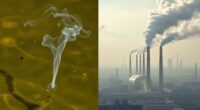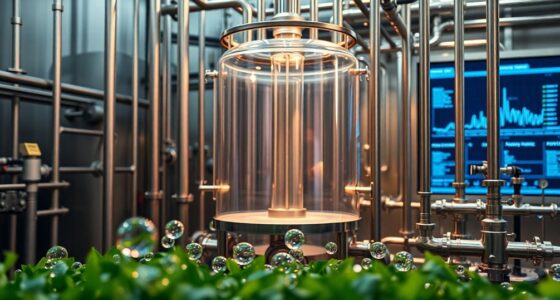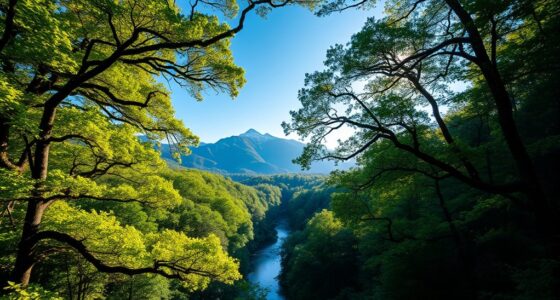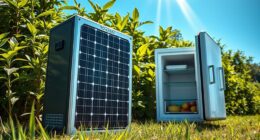Surfaces with high albedo, like snow and ice, reflect more sunlight, helping cool the climate, while dark surfaces like asphalt absorb heat and warm the environment. Urban areas with low albedo increase local temperatures, creating heat islands, and contribute to global warming. Changes in land cover and surface materials directly influence climate patterns. To understand how managing surface reflectivity can help mitigate climate change, keep exploring the important role of albedo.
Key Takeaways
- Surface albedo determines how much sunlight is reflected or absorbed, directly influencing local and global temperatures.
- High-albedo surfaces like snow and ice help cool the climate by reflecting sunlight, whereas dark surfaces absorb heat.
- Urban areas with low albedo materials contribute to the urban heat island effect, raising city temperatures.
- Modifying surface reflectivity, such as using light-colored rooftops and pavements, can mitigate climate warming.
- Surface properties significantly impact Earth’s climate system, making albedo management a key tool in climate change mitigation.
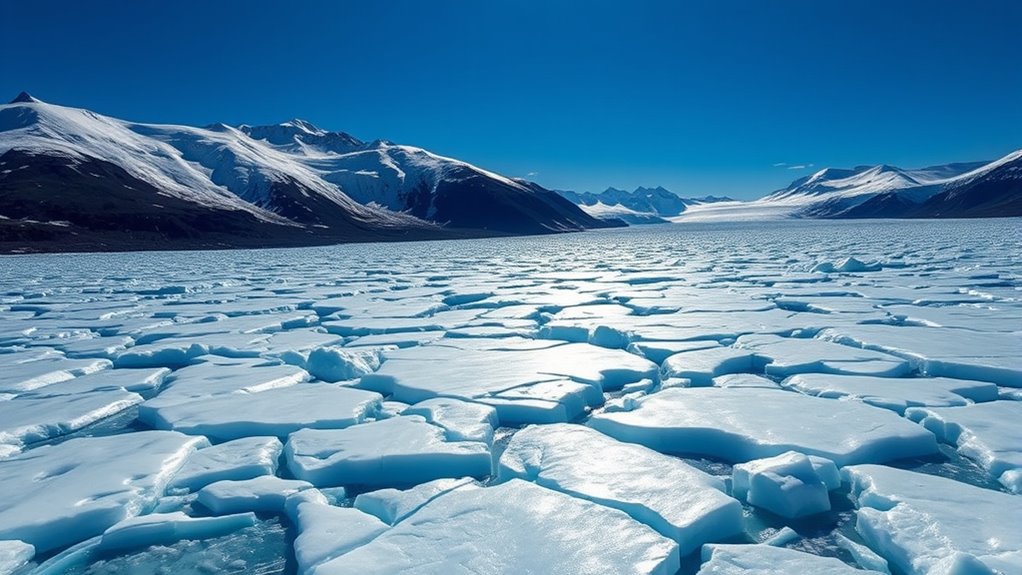
Have you ever wondered how Earth’s surface reflects sunlight and influences its climate? The answer lies in the concept of albedo, which measures how much sunlight a surface reflects back into space. Different surfaces have varying albedos; for example, snow and ice reflect a significant portion of sunlight, while dark asphalt absorbs more. These reflectivity effects directly impact local and global temperatures. When surfaces with high albedo reflect more sunlight, they help cool the planet, whereas darker surfaces absorb heat, contributing to warming. This simple property plays a fundamental role in regulating Earth’s climate system.
In urban environments, the phenomenon of urban heat becomes especially relevant. Cities tend to have lower albedo because of extensive concrete, asphalt, and other dark materials. These surfaces absorb a large amount of solar radiation, causing temperatures in cities to soar higher than surrounding rural areas. This effect, known as the urban heat island, can raise temperatures by several degrees, especially during the summer months. The high concentration of dark, reflective surfaces diminishes the reflectivity effects that help moderate the climate. As a result, urban areas not only experience more heat but also contribute to global warming by emitting more heat into the atmosphere. Recognizing how urban heat works emphasizes the importance of considering surface reflectivity in city planning, such as adding reflective rooftops or lighter-colored pavements to improve albedo.
The reflectivity effects of surfaces extend beyond cities. Large swaths of land covered in vegetation, snow, or ice have high albedo, helping cool the environment. Conversely, deforestation and land degradation reduce the overall reflectivity, leading to increased heat absorption. Even individual choices, like using lighter-colored paints or materials, can influence local albedo and contribute to climate change mitigation. The key takeaway is that surface properties matter—altering the reflectivity of a specific area can have ripple effects on the atmosphere and climate.
Understanding how Earth’s surface reflects sunlight ties directly into efforts to combat climate change. By managing the albedo of urban areas and natural landscapes, we can influence local temperatures and reduce the overall heat trapped in our atmosphere. It’s a simple yet powerful tool—changing the color or material of surfaces can help keep our cities cooler and lessen the impact of climate change. So, next time you see a white roof or light-colored pavement, remember that it’s not just about aesthetics; it’s about harnessing reflectivity effects to shape a more sustainable future.
Frequently Asked Questions
How Does Albedo Affect Local Weather Patterns?
You can see that albedo influences local weather patterns by affecting solar reflectance. Surfaces with high albedo, like snow or ice, reflect more sunlight, which keeps surface temperatures lower and reduces heat absorption. Conversely, darker surfaces absorb more solar energy, raising surface temperatures. This variation impacts local weather, causing differences in temperature, humidity, and even cloud formation, ultimately shaping the climate of your area.
Can Changing Surface Albedo Reverse Climate Change?
Changing surface albedo alone can’t reverse climate change, but geoengineering solutions like reflective surfaces or aerosols might help reduce warming temporarily. You should consider that these methods could have significant ecological impacts, disrupting ecosystems and weather patterns. While increasing albedo offers some promise, it’s not a standalone fix. Instead, focus on reducing greenhouse gases to address the root cause of climate change effectively.
What Are Natural vs. Artificial Surface Albedo Modifications?
Natural surface albedo modifications involve changes like snow cover, vegetation, or mineral surfaces that influence surface reflectivity naturally. Artificial modifications, part of albedo management, include painting roofs white or using reflective materials to increase surface reflectivity intentionally. You can leverage both approaches to influence local climate; natural changes happen over time, while artificial methods are actively implemented to reduce heat absorption and combat climate change.
How Do Urban Surfaces Influence Regional Albedo Levels?
Urban surfaces act like a mirror, bouncing sunlight back into the atmosphere and raising regional albedo levels. You’ll notice reflective pavements and lighter roofs reduce urban heat, helping cities stay cooler. By choosing materials with higher albedo, you can lessen heat absorption, mitigate urban heat islands, and improve air quality. These surface modifications turn cities into reflective landscapes, balancing heat and light to influence local climate patterns positively.
Are There Any Future Technologies to Manipulate Albedo Intentionally?
Future technologies like geoengineering strategies and innovative reflective materials aim to intentionally manipulate albedo. You might see developments in aerosol injection, cloud brightening, or reflective surface coatings designed to reduce heat absorption. These methods could help control local and global temperatures. While promising, they also raise ethical and environmental concerns. As these technologies evolve, careful research and regulation will be vital to guarantee safe, effective climate management.
Conclusion
Understanding albedo helps you see how surfaces influence climate, from snow-covered fields to urban rooftops. Did you know that ice and snow reflect up to 90% of sunlight, considerably cooling the planet? By appreciating how different surfaces absorb or reflect sunlight, you can better grasp climate change impacts and solutions. So next time you see a snowy landscape or dark asphalt, remember how these surfaces play a crucial role in shaping our Earth’s climate.

